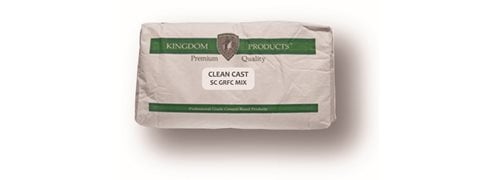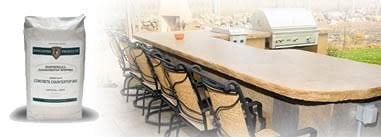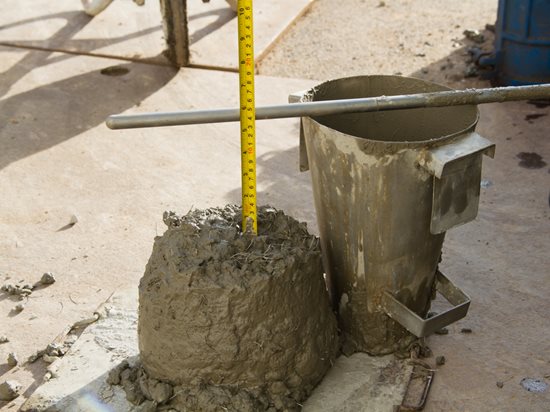- Concrete mix design
- Materials: What goes into the mix
- Concrete Slump
- Concrete mixes for hot weather
- Concrete mixes for cold weather
- Mix Designs for Different Types of Decorative Work
- Mixes for stamped concrete
- Mixes for stained concrete
- Mixes for concrete driveways
- Related Information:
- Concrete admixtures: Tips for using in the concrete mix
- Ordering concrete from ready-mix suppliers
- Concrete Mix Design in Southeast Asia
Concrete Slump 101
Learn the basics of how to test for concrete slump and what the results can tell you about the quality of your concrete.When was the last time you tested the concrete delivered to your jobsite for slump? Many decorative concrete contractors will admit that they don’t conduct the slump test very often, if at all, assuming that the concrete was batched to meet their exact specifications.
Although the typical residential decorative concrete job doesn’t require concrete to be a certain slump, it is still a useful measure for determining that the concrete is the right consistency for your project before you place it, giving you extra assurance of good long-term performance.
What is concrete slump?
Concrete slump is a measure of the consistency or workability of fresh concrete. It indicates how easily the mix flows and is often used to evaluate water content. A low slump means the concrete is stiff and dry; a high slump means it is more fluid and easier to work with.
Learn more about concrete mix design best practices.
Slump values are measured in the number of inches fresh concrete “slumps,” or sinks, when removed from an inverted 12-inch-tall cone. The value can range from nearly zero, which means the concrete is extremely stiff and has almost no workability, to a degree where the concrete is so wet and flowable that it completely collapses when removed from the cone. On most projects, the ideal slump is somewhere in between these two extremes, with the concrete being workable enough for easy placing and finishing but having adequate cohesion to prevent segregation and loss of strength.
YouTube Short by Victory Outdoor Services
How do you test for concrete slump?
Testing for concrete slump is a quick procedure that can be performed on the jobsite using relatively inexpensive, but specialized, equipment. For ready-mix concrete, the procedures for measuring slump are defined by ASTM C143 – Standard Test Method for Slump of Hydraulic-Cement Concrete.
The basic items you’ll need to perform the test include a slump cone, a baseplate to rest the cone on during the test, a steel rod to tamp down the concrete, and a tape measure or ruler to measure the slump of the concrete after the cone is removed. The results of the test will tell you the degree of workability of the concrete, which will allow you determine if it’s suitable for your application (see table).
Learn more about the procedures for conducting an accurate concrete slump test.
Why is a slump test needed?
Knowing what the consistency of your concrete mix is when it arrives on the jobsite allows you to make adjustments to the concrete before placement and prevent potential problems later, after the concrete sets. It also is a way to confirm that the concrete you ordered from the ready-mix supplier is within industry standards specific to its purpose and is uniform from batch to batch.
| CONCRETE SLUMP READING | WORKABILITY | TYPICAL APPLICATIONS |
|---|---|---|
| 0 to 1 inch | Very low | Very dry mixes used in constructing pavements or roads. |
| 1 to 2 inches | Low | Mixes used for foundations with light reinforcement. |
| 2 to 4 inches | Medium | Manually compacted flat slabs. |
| 4 to 7 inches | High | Sections where reinforcing has tight spacing or the concrete has to flow a great distance. |
What happens if the slump is too high or low?
When concrete has a higher-than-specified slump, or is too wet, it becomes weaker and more susceptible to cracking. As a general rule, every additional inch of slump reduces concrete’s compressive strength by about 500 psi.
As you increase the amount of water in a mix, you also increase the porosity of the hardened concrete, making it more vulnerable to damage caused freeze-thaw conditions and deicing salts. If you’re working with integrally colored concrete, changing the slump by the addition of excess water can reduce the intensity of the color.
Concrete with a slump that is too low for the application can also present problems. It can be difficult to work with and will require more effort to spread and finish. Low-slump concrete is also thicker and more difficult to consolidate, making it unsuitable for use in heavily reinforced slabs and foundations.
What is the best slump for decorative concrete flatwork?
For most exterior decorative concrete, a slump ranging from 4 to 5 inches is ideal. You want the mix to be similar in consistency to thick oatmeal, without being watery. Avoid slumps greater than 5 inches because an overly wet mix can reduce overall strength and result in a weak, porous surface.
How do water-reducing admixtures affect concrete slump?
Water reducers and superplasticizers are great alternatives to increasing the slump of a concrete mix without adding excess water. Not only will these admixtures increase the flow and enhance the workability of a concrete mix, they may also boost the strength because less water is needed, with reductions ranging from 10 to 40 percent, depending on the product used.
What should you do when a load of concrete is too wet?
If the slump of the concrete delivered to your jobsite is significantly higher than what the job demands, you should reject the concrete mix or take measures to get it within the desired range.
Many specifications permit slump variations of up to 1 inch. If the slump exceeds 1½ inches from what was ordered, the quality of the concrete can be significantly compromised.
Be aware that if you accept the concrete or ask the concrete supplier to add water to the mix in excess of industry standards, you assume the responsibility for the resulting concrete quality.
 Clean Cast GFRC Mix
Available in white or gray, in 50lb bags
Clean Cast GFRC Mix
Available in white or gray, in 50lb bags
 Contractor-Pak
Contains six of our most effective admixtures
Contractor-Pak
Contains six of our most effective admixtures
 Imperial Countertop Mix
Engineered to be lightweight and strong. Minimal shrinkage.
Imperial Countertop Mix
Engineered to be lightweight and strong. Minimal shrinkage.
 Butterfield Cantera Wall Mix
Just Add Water
Butterfield Cantera Wall Mix
Just Add Water
 Integral Color + Fiber
Brickform Ultra-M1x blends pigments and reinforcement fibers
Integral Color + Fiber
Brickform Ultra-M1x blends pigments and reinforcement fibers
 NCA (Non-Chloride Accelerator)
All weather admixture
NCA (Non-Chloride Accelerator)
All weather admixture





